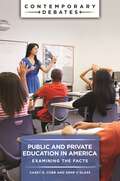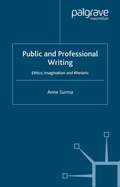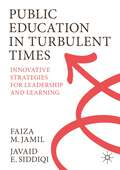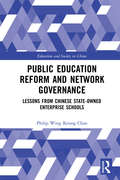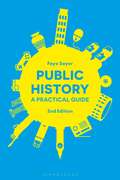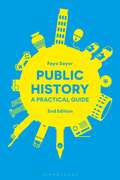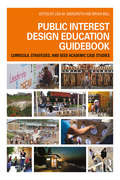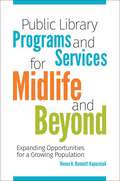- Table View
- List View
Public and Private Education in America: Examining the Facts (Contemporary Debates)
by Casey D. Cobb Gene V GlassThis title will give students and other readers a clear understanding of the true state of public and private education systems in the United States by refuting falsehoods, misunderstandings, and exaggerations—and confirming the validity of other assertions.This work is part of a series that uses evidence-based documentation to examine the veracity of claims and beliefs about high-profile issues in American culture and politics. Each book in the Contemporary Debates series is intended to puncture rather than perpetuate myths that diminish our understanding of important policies and positions; to provide needed context for misleading statements and claims; and to confirm the factual accuracy of other assertions.This particular volume examines beliefs, claims, and myths about public and private K–12 education in the United States. Issues covered include categories of public and private schools and variations in academic performance and socioeconomic status therein; controversies surrounding school choice, including school vouchers and charter schools; accountability and assessment of private and public schools; debates about school environment, safety, and curricula; and teacher and administrator quality. All of these issues are examined in individualized entries, with objective responses grounded in up-to-date evidence.
Public and Private Education in America: Examining the Facts (Contemporary Debates)
by Casey D. Cobb Gene V GlassThis title will give students and other readers a clear understanding of the true state of public and private education systems in the United States by refuting falsehoods, misunderstandings, and exaggerations—and confirming the validity of other assertions.This work is part of a series that uses evidence-based documentation to examine the veracity of claims and beliefs about high-profile issues in American culture and politics. Each book in the Contemporary Debates series is intended to puncture rather than perpetuate myths that diminish our understanding of important policies and positions; to provide needed context for misleading statements and claims; and to confirm the factual accuracy of other assertions.This particular volume examines beliefs, claims, and myths about public and private K–12 education in the United States. Issues covered include categories of public and private schools and variations in academic performance and socioeconomic status therein; controversies surrounding school choice, including school vouchers and charter schools; accountability and assessment of private and public schools; debates about school environment, safety, and curricula; and teacher and administrator quality. All of these issues are examined in individualized entries, with objective responses grounded in up-to-date evidence.
Public and Professional Writing: Ethics, Imagination and Rhetoric
by A. SurmaThis book offers something quite new - an advanced textbook that considers professional writing as a negotiated process between writer and reader. Arguing that ethics, imagination and rhetoric are integral to professional writing praxis, the book encourages students to look critically at various writing practices in a range of contexts. A textbook for advanced undergraduates and postgraduates in Linguistics, Communication, Journalism and Media Studies.
Public Education in the Digital Age: Neoliberalism, EdTech, and the Future of Our Schools
by Morgan AndersonEducational technology is now ubiquitous in schooling, both in P-12 and at universities. Despite the imposition of technology in most aspects of teaching and learning, little attention has been given to the implications educational technology has for healthy student development, humane pedagogy, teacher labor, academic freedom, and the aims of social justice. Rather than merely a set of neutral tools, educational technology is bound up with systems of power and privilege that tend to deepen, rather than confront inequality. In calling for a reassessment of the relationship between schools and technology, this book asks readers to think differently about the role technology can serve in socially just schools. An accessible and compelling read, this book will appeal to students and scholars of sociology, social justice, politics, and all those interested in the impact technology is having on the education system in the USA.
Public Education in the Digital Age: Neoliberalism, EdTech, and the Future of Our Schools
by Morgan AndersonEducational technology is now ubiquitous in schooling, both in P-12 and at universities. Despite the imposition of technology in most aspects of teaching and learning, little attention has been given to the implications educational technology has for healthy student development, humane pedagogy, teacher labor, academic freedom, and the aims of social justice. Rather than merely a set of neutral tools, educational technology is bound up with systems of power and privilege that tend to deepen, rather than confront inequality. In calling for a reassessment of the relationship between schools and technology, this book asks readers to think differently about the role technology can serve in socially just schools. An accessible and compelling read, this book will appeal to students and scholars of sociology, social justice, politics, and all those interested in the impact technology is having on the education system in the USA.
Public Education in Turbulent Times: Innovative Strategies for Leadership and Learning
by Faiza M. Jamil Javaid E. SiddiqiPublic Education in Turbulent Times communicates a bold vision for the future of education, addressing the evolving purpose of American public education and the structural innovations schools are using to meet the needs of a rapidly transforming world. Highlighting key challenges that emerged during the immense economic and social disruptions of recent years, the book leverages case studies of four unique school districts where school communities overcame concerns high in the public consciousness – trauma, danger, economic inequality, and racial injustice. These obstacles have hampered efforts to reclaim lost learning opportunities that could define the educational experiences of a generation of students. If educators revert to business as usual, they risk dismissing essential lessons from resilient schools that thrived in the chaos of a global pandemic and its fallout. This book provides rich insights to refocus readers’ attention on achieving a more equitable and safe education system for the future.
Public Education Reform and Network Governance: Lessons From Chinese State-Owned Enterprise Schools (Education and Society in China)
by Philip Wing ChanThis book is located in the field of education governance and sits amidst debates on public school reform in China. It examines how a top-down policy approach has been implemented from central government right down to the district level within the public education system in China. It shows the way networks support negotiation and bargaining at the district level which, in turn, influences the broader education policy of the central government. Using statistical data from education yearbooks, government documents analysis and interviews with main stakeholders in this policy arena, the book incorporates case studies from railway State-Owned Enterprise schools. Analysis of these indicates that the processes of formulating and implementing Chinese education policy can be characterised as a form of network governance, which coordinates actors, decision-making processes and stakeholders’ motivation to comply with collective decisions in Chinese education. Network governance acts as an effective and legitimate way of problem solving that assists policy implementation and education reform in China. By comparing two traditional modes of governance (governance through bureaucracy and the governance through markets), this book shows the network mode of governance in Chinese education is more powerful and significant, especially since the negotiated results among actors in the policy community are favourable.
Public Education Reform and Network Governance: Lessons From Chinese State-Owned Enterprise Schools (Education and Society in China)
by Philip Wing ChanThis book is located in the field of education governance and sits amidst debates on public school reform in China. It examines how a top-down policy approach has been implemented from central government right down to the district level within the public education system in China. It shows the way networks support negotiation and bargaining at the district level which, in turn, influences the broader education policy of the central government. Using statistical data from education yearbooks, government documents analysis and interviews with main stakeholders in this policy arena, the book incorporates case studies from railway State-Owned Enterprise schools. Analysis of these indicates that the processes of formulating and implementing Chinese education policy can be characterised as a form of network governance, which coordinates actors, decision-making processes and stakeholders’ motivation to comply with collective decisions in Chinese education. Network governance acts as an effective and legitimate way of problem solving that assists policy implementation and education reform in China. By comparing two traditional modes of governance (governance through bureaucracy and the governance through markets), this book shows the network mode of governance in Chinese education is more powerful and significant, especially since the negotiated results among actors in the policy community are favourable.
Public Engagement for Public Education: Joining Forces to Revitalize Democracy and Equalize Schools
by John Rogers Marion OrrCommunity participation plays a large role in the success or failure of our public schools. This book focuses attention on the problem of inequality in public engagement, considering how race, class, ethnicity, language, and immigration status shape opportunities for engagement. Without the active participation of the public, chances for improving school systems are limited. Without equal opportunity for public engagement, those in the lower reaches of stratified society are left largely on the outside looking in—and that all too easily becomes a self-perpetuating cycle. Public Engagement for Public Education speaks to the potential for students, parents, community members, and civic leaders to join forces and create more equitable schooling. Such engagement can expand access to quality educational pathways which in turn paves the way to a stronger voice in society and the promise of the American dream. If segments of society are blocked access to those pathways, the book argues, nothing less than the health of American democracy is at stake.
Public Governance und schwache Interessen
by Ute Clement Jörg Nowak Christoph Scherrer Sabine RußDie neuen staatlichen Steuerungsformen unter Beteiligung nicht-staatlicher Akteure werden breit unter dem Begriff ,Governance' diskutiert. Wenig Beachtung findet jedoch bisher die Frage, wie sich diese auf sogenannte schwache Interessen auswirken. Damit sind solche Akteure gemeint, die über wenige Ressourcen verfügen und wenig mobilisierungsfähig sind. Diese Machtdimension untersucht der Band mit empirisch fundierten Beiträgen zur Frage, ob 'Governance' unterprivilegierten Akteuren neue Partizipationschancen erschließt oder ob ihre Handlungsmöglichkeiten stärker begrenzt werden. Der interdisziplinäre Ansatz verbindet Perspektiven der Pädagogik, Politologie, Soziologie, Jurisprudenz und Ökonomie. Die Vielfalt der Perspektiven trägt der Interdependenz von verschiedenen Regelungsstrukturen Rechnung und erweitert die Governance-Forschung um herrschaftstheoretische, rechtswissenschaftliche und politökonomische Aspekte.
Public Health: A Global Perspective
by Hari SinghPublic health is the science and art of improving the health and well-being of communities. Public health interventions go beyond individual healthcare to focus on preventing diseases and injuries, promoting healthy behaviors, and addressing sociocultural, economic, and environmental factors that impact health.While topics of public health, such as maternal health, child health, and epidemiology of infectious and noncommunicable diseases, require familiarity with clinical terms and concepts, the author demystifies medical knowledge to make it accessible to a wider audience. Challenges faced by low-income countries, as well as success stories from developed nations, are included to make the book relevant for global readers.With a focus on essentials and priority issues, the author employs simple and straightforward language to present situational cases that shed light on global public health challenges and possible interventions. To stimulate analytical thinking and encourage readers to approach the subject with scientific rigor, concepts and facts are substantiated with their background, rationale, or application. Readers should be able to relate learnings with their field experience.While this book is primarily for public health practitioners, including community health nurses and physicians, social workers, and health managers, it may be a valuable resource for anyone interested in public health and its application in creating healthier societies.
Public Health: A Global Perspective
by Hari SinghPublic health is the science and art of improving the health and well-being of communities. Public health interventions go beyond individual healthcare to focus on preventing diseases and injuries, promoting healthy behaviors, and addressing sociocultural, economic, and environmental factors that impact health.While topics of public health, such as maternal health, child health, and epidemiology of infectious and noncommunicable diseases, require familiarity with clinical terms and concepts, the author demystifies medical knowledge to make it accessible to a wider audience. Challenges faced by low-income countries, as well as success stories from developed nations, are included to make the book relevant for global readers.With a focus on essentials and priority issues, the author employs simple and straightforward language to present situational cases that shed light on global public health challenges and possible interventions. To stimulate analytical thinking and encourage readers to approach the subject with scientific rigor, concepts and facts are substantiated with their background, rationale, or application. Readers should be able to relate learnings with their field experience.While this book is primarily for public health practitioners, including community health nurses and physicians, social workers, and health managers, it may be a valuable resource for anyone interested in public health and its application in creating healthier societies.
Public Health Perspectives on Disability: Science, Social Justice, Ethics, and Beyond
by Donald J. Lollar Willi Horner-Johnson Katherine Froehlich-GrobeIn this new edition, the editors and contributors update and expand on the educational framework that was introduced in the first edition for rethinking disability in public health study and practice and for attaining the competencies that should accompany this knowledge. The second edition highlights key areas of research that have emerged since the first edition was published. This edition includes new and updated chapters that have particular relevance for public health practice: Disability, Intersectionality, and Inequity: Life in the MarginsDisability and Health Programs: Emerging PartnersChildren with Special Healthcare NeedsDisasters and Disability: Rhetoric and RealityInter-relationship of Health Insurance and Employment for People with DisabilitiesPublic Health, Work, and DisabilityActions to Prepare a Competent Workforce Public Health Perspectives on Disability: Science, Social Justice, Ethics, and Beyond, 2nd Edition, is an essential resource for public health educators and practitioners as well as students in graduate schools of public health throughout the United States.
Public History: A Textbook of Practice
by Thomas CauvinPublic History: A Textbook of Practice is a guide to the many challenges historians face while teaching, learning, and practicing public history. Historians can play a dynamic and essential role in contributing to public understanding of the past, and those who work in historic preservation, in museums and archives, in government agencies, as consultants, as oral historians, or who manage crowdsourcing projects need very specific skills. This book links theory and practice and provides students and practitioners with the tools to do public history in a wide range of settings. The text engages throughout with key issues such as public participation, digital tools and media, and the internationalization of public history. Part One focuses on public history sources, and offers an overview of the creation, collection, management, and preservation of public history materials (archives, material culture, oral materials, or digital sources). Chapters cover sites and institutions such as archival repositories and museums, historic buildings and structures, and different practices such as collection management, preservation (archives, objects, sounds, moving images, buildings, sites, and landscape), oral history, and genealogy. Part Two deals with the different ways in which public historians can produce historical narratives through different media (including exhibitions, film, writing, and digital tools). The last part explores the challenges and ethical issues that public historians will encounter when working with different communities and institutions. Either in public history methods courses or as a resource for practicing public historians, this book lays the groundwork for making meaningful connections between historical sources and popular audiences.
Public History: A Textbook of Practice
by Thomas CauvinPublic History: A Textbook of Practice is a guide to the many challenges historians face while teaching, learning, and practicing public history. Historians can play a dynamic and essential role in contributing to public understanding of the past, and those who work in historic preservation, in museums and archives, in government agencies, as consultants, as oral historians, or who manage crowdsourcing projects need very specific skills. This book links theory and practice and provides students and practitioners with the tools to do public history in a wide range of settings. The text engages throughout with key issues such as public participation, digital tools and media, and the internationalization of public history. Part One focuses on public history sources, and offers an overview of the creation, collection, management, and preservation of public history materials (archives, material culture, oral materials, or digital sources). Chapters cover sites and institutions such as archival repositories and museums, historic buildings and structures, and different practices such as collection management, preservation (archives, objects, sounds, moving images, buildings, sites, and landscape), oral history, and genealogy. Part Two deals with the different ways in which public historians can produce historical narratives through different media (including exhibitions, film, writing, and digital tools). The last part explores the challenges and ethical issues that public historians will encounter when working with different communities and institutions. Either in public history methods courses or as a resource for practicing public historians, this book lays the groundwork for making meaningful connections between historical sources and popular audiences.
Public History: A Practical Guide
by Faye SayerThe 2nd edition of Public History: A Practical Guide provides a fresh examination of history as practiced in its various worldly guises and contexts. It analyses the many skills that historians require in the practice of public history and looks at how a range of actors, including museums, archives, government agencies, community history societies and the media/digital media, make history accessible to a wider audience in a variety of ways.Faye Sayer's exciting new edition includes: * Brand new chapters on 'Restoration and Preservation' and history and the working world* Substantial additions covering the growing fields of digital history and history in politics* More images, figures and international case studies from the US, Australia, the UK, Europe and Asia* 'Personal Reflection' sections from a range of industry experts from around the world* Historiographical updates and significant revisions throughout the text* Expanded online 'Public History Toolkit' resource, with a range of new features Public History: A Practical Guide delivers a comprehensive outline of this increasingly prevalent area of the discipline, offering a distinctly global approach that is both accessible and engaging in equal measure. Finally, it explores future methodological possibilities and can be used as a reference point for professional development planning in the sectors discussed. This is the essential overview for any student wanting to know what history means beyond the classroom.
Public History: A Practical Guide
by Faye SayerThe 2nd edition of Public History: A Practical Guide provides a fresh examination of history as practiced in its various worldly guises and contexts. It analyses the many skills that historians require in the practice of public history and looks at how a range of actors, including museums, archives, government agencies, community history societies and the media/digital media, make history accessible to a wider audience in a variety of ways.Faye Sayer's exciting new edition includes: * Brand new chapters on 'Restoration and Preservation' and history and the working world* Substantial additions covering the growing fields of digital history and history in politics* More images, figures and international case studies from the US, Australia, the UK, Europe and Asia* 'Personal Reflection' sections from a range of industry experts from around the world* Historiographical updates and significant revisions throughout the text* Expanded online 'Public History Toolkit' resource, with a range of new features Public History: A Practical Guide delivers a comprehensive outline of this increasingly prevalent area of the discipline, offering a distinctly global approach that is both accessible and engaging in equal measure. Finally, it explores future methodological possibilities and can be used as a reference point for professional development planning in the sectors discussed. This is the essential overview for any student wanting to know what history means beyond the classroom.
Public Housing and School Choice in a Gentrified City: Youth Experiences of Uneven Opportunity (Palgrave Studies in Urban Education)
by M. MakrisWinner of the 2016 AESA Critics' Choice Book Award Molly Makris uses an interdisciplinary approach to urban education policy to examine the formal education and physical environment of young people from low-income backgrounds and demonstrate how gentrification shapes these circumstances.
Public Interest Design Education Guidebook: Curricula, Strategies, and SEED Academic Case Studies (Public Interest Design Guidebooks)
by Lisa M. Abendroth Bryan BellPublic Interest Design Education Guidebook: Curricula, Strategies, and SEED Academic Case Studies presents the pedagogical framework and collective curriculum necessary to teach public interest designers. The second book in Routledge’s Public Interest Design Guidebook series, the editors and contributors feature a range of learning competencies supported by distinct teaching strategies where educational and community-originated goals unite. Written in a guidebook format that includes projects from across design disciplines, this book describes the learning deemed most critical to pursuing an inclusive, informed design practice that meets the diverse needs of both students and community partners. Featured chapter themes include Fundamental Skills, Intercultural Competencies, Engaging the Field Experience, Inclusive Iteration, and Evaluating Student Learning. The book consists of practice-based and applied learning constructs that bridge community-based research with engaged learning and design practice. SEED (Social Economic Environmental Design) academic case studies introduce teaching strategies that reinforce project-specific learning objectives where solving social, economic, and environmental issues unites the efforts of communities, student designers, and educators. This comprehensive publication also contains indices devoted to learning objectives cross-referenced from within the book as well as considerations for educational program development in public interest design. Whether you are a student of design, an educator, or a designer, the breadth of projects and teaching strategies provided here will empower you to excel in your pursuit of public interest design.
Public Interest Design Education Guidebook: Curricula, Strategies, and SEED Academic Case Studies (Public Interest Design Guidebooks)
by Lisa M. Abendroth Bryan BellPublic Interest Design Education Guidebook: Curricula, Strategies, and SEED Academic Case Studies presents the pedagogical framework and collective curriculum necessary to teach public interest designers. The second book in Routledge’s Public Interest Design Guidebook series, the editors and contributors feature a range of learning competencies supported by distinct teaching strategies where educational and community-originated goals unite. Written in a guidebook format that includes projects from across design disciplines, this book describes the learning deemed most critical to pursuing an inclusive, informed design practice that meets the diverse needs of both students and community partners. Featured chapter themes include Fundamental Skills, Intercultural Competencies, Engaging the Field Experience, Inclusive Iteration, and Evaluating Student Learning. The book consists of practice-based and applied learning constructs that bridge community-based research with engaged learning and design practice. SEED (Social Economic Environmental Design) academic case studies introduce teaching strategies that reinforce project-specific learning objectives where solving social, economic, and environmental issues unites the efforts of communities, student designers, and educators. This comprehensive publication also contains indices devoted to learning objectives cross-referenced from within the book as well as considerations for educational program development in public interest design. Whether you are a student of design, an educator, or a designer, the breadth of projects and teaching strategies provided here will empower you to excel in your pursuit of public interest design.
Public Libraries and the Internet: Roles, Perspectives, and Implications
by John Carlo Ph.D. Charles R. McClure Paul T. JaegerThis book is a timely and detailed exploration of the impact and issues of the Internet in public libraries and their implications for society, policy, and professional practice.Public Libraries and the Internet: Roles, Perspectives, and Implications explores the impact of the Internet and the expansion of the networked environment on U.S. public libraries through more than a dozen essays written by leading scholars and administrators. Notwithstanding the far-reaching changes wrought by the Internet, this is the first attempt to provide a comprehensive exploration of the subject over time and across areas of practice.This wide-ranging volume, edited by the authors of several national studies tracking the use and involvement of public libraries with the Internet since 1994, offers both description and assessment. It discusses the ways in which the roles and services of public libraries have changed as a result of the Internet and offers a perspective on the meaning and impact of these changes. Perhaps most critically, it also suggests possible futures and opportunities as public libraries continue to evolve in this networked environment.
Public Library Programs and Services for Midlife and Beyond: Expanding Opportunities for a Growing Population
by Reneé K. Bennett-KapusniakInspired by trends in U.S. public libraries, this book teaches librarians how to create a welcoming environment that enriches, enlightens, and engages their library's growing aging community.The number of adults aged 50+ coming to public libraries is steadily increasing. These patrons include active, healthy, tech-savvy professionals; people who have little or no computer training; retirees; travelers; and those who have age-related health and behavior issues. Public libraries have an opportunity to provide services for this growing and varied group. This book teaches librarians how to develop and expand adult public library programming and services, turning their library into a welcoming environment for the aging community.Public Library Programs and Services for Midlife and Beyond offers practical examples in areas including community collaboration, outreach, marketing, engagement, technology and social media, funding, and lifelong learning. It also incorporates up-to-date findings from the ALA's Guidelines for Library Services with 60+ Audience: Best Practices. Examples gathered by the author from extensive interviews with public librarians and directors illustrate what a range of libraries is successfully doing for the midlife-and-beyond community and encourage creative thinking about new programs and services.
Public Library Programs and Services for Midlife and Beyond: Expanding Opportunities for a Growing Population
by Reneé K. Bennett-KapusniakInspired by trends in U.S. public libraries, this book teaches librarians how to create a welcoming environment that enriches, enlightens, and engages their library's growing aging community.The number of adults aged 50+ coming to public libraries is steadily increasing. These patrons include active, healthy, tech-savvy professionals; people who have little or no computer training; retirees; travelers; and those who have age-related health and behavior issues. Public libraries have an opportunity to provide services for this growing and varied group. This book teaches librarians how to develop and expand adult public library programming and services, turning their library into a welcoming environment for the aging community.Public Library Programs and Services for Midlife and Beyond offers practical examples in areas including community collaboration, outreach, marketing, engagement, technology and social media, funding, and lifelong learning. It also incorporates up-to-date findings from the ALA's Guidelines for Library Services with 60+ Audience: Best Practices. Examples gathered by the author from extensive interviews with public librarians and directors illustrate what a range of libraries is successfully doing for the midlife-and-beyond community and encourage creative thinking about new programs and services.
Public Medievalists, Racism, and Suffrage in the American Women’s College (PDF)
by Mary Dockray-MillerThis study, part of growing interest in the study of nineteenth-century medievalism and Anglo-Saxonism, closely examines the intersections of race, class, and gender in the teaching of Anglo-Saxon in the American women’s colleges before World War I, interrogating the ways that the positioning of Anglo-Saxon as the historical core of the collegiate English curriculum also silently perpetuated mythologies about Manifest Destiny, male superiority, and the primacy of northern European ancestry in United States culture at large. Analysis of college curricula and biographies of female professors demonstrates the ways that women used Anglo-Saxon as a means to professional opportunity and political expression, especially in the suffrage movement, even as that legitimacy and respectability was freighted with largely unarticulated assumptions of racist and sexist privilege. The study concludes by connecting this historical analysis with current charged discussions about the intersections of race, class, and gender on college campuses and throughout US culture.
Public No More: A New Path to Excellence for America’s Public Universities
by Andrew J. Policano Gary C. FethkePublic No More examines the quickly changing environment within higher education, including the permanent decline in state support for public universities. This book raises the question of how research universities can survive with reduced subsidies and increased competition from both non-profit and growing for-profit institutions. Authors Gary C. Fethke and Andrew J. Policano, both longtime university administrators, offer a strategic framework for determining how tuition and access should be set and how universities should decide on quality and program scope. Throughout the text, real-world examples illustrate successful and unsuccessful adoptions of the authors' proposals. Leadership within public higher education, policymakers, and researchers alike will find Public No More to be a sober and well-grounded guide to what lies ahead for universities across the nation.

